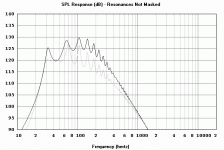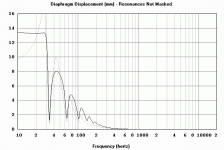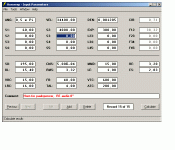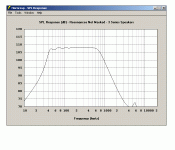Comparison of Adire Koda Mk1 (not sure of all params unfortunately) and Tang Band W8 740C.
The darker line is the Tang band and the grey is the Koda 8"
The Tangband has 150w but the Koda has 100w, which does not concern me as both have plenty of SPL
There will be some eq for the TB to get the peak down which will make excursion acceptable, but since the koda is already flat, I've given it less power; it would have a highpass to control excursion.
Which is better?
Keep in mind that I will eq with ultracurve
The koda is flat at the bottom end but is more difficult to eq on the top end.
Anyone have advice on what to look for with sims? I'm finding it a bit hard to know if what I see is a good thing or not!
The darker line is the Tang band and the grey is the Koda 8"
The Tangband has 150w but the Koda has 100w, which does not concern me as both have plenty of SPL
There will be some eq for the TB to get the peak down which will make excursion acceptable, but since the koda is already flat, I've given it less power; it would have a highpass to control excursion.
Which is better?
Keep in mind that I will eq with ultracurve
The koda is flat at the bottom end but is more difficult to eq on the top end.
Anyone have advice on what to look for with sims? I'm finding it a bit hard to know if what I see is a good thing or not!
Attachments
Some more questions first:
Can you post a view of the input window as well? A lot of information is in there. Furtermore, what's the Xmax of both the units, what is your intended frequency range (30ish?) and how are you most likely going to load the cabinet into space?
Do the dimensions mentioned (100 x 60 x) in the other topic apply to this horn?
Mvg Johan
Can you post a view of the input window as well? A lot of information is in there. Furtermore, what's the Xmax of both the units, what is your intended frequency range (30ish?) and how are you most likely going to load the cabinet into space?
Do the dimensions mentioned (100 x 60 x) in the other topic apply to this horn?
Mvg Johan
Johan, they both have an xmax of about 12mm
corner loaded (most likely)
40 - 120 Hz ideally
I don't really need lower than 40 since my subs take over down there, but it just so happens that they seem to get down to 30 Hz! I'd actually rather they were smaller, or that the response was smoother, or that they don't need corner loading, than have 30 Hz extension.
100 x 60 x 40 would be a good size I could live with, although doing some work on cad I found it hard to work with those dimensions! It seems easier to design when it is square. I want to avoid greater than 90 degree bends.
Simon,
If you have ideas how to get it flatter I'm all ears. However, I notice that even the lab horn isn't that smooth, and yet when I've tried modelling it, I could get it smoother, and Danley could have easily done that as well. So I ask why he didn't. Obviously there is more to it, so I'm trying to learn some of the rules of horn design. With sealed and vented boxes, we have a better idea of how the response should look, but in this case I'm not so sure.
corner loaded (most likely)
40 - 120 Hz ideally
I don't really need lower than 40 since my subs take over down there, but it just so happens that they seem to get down to 30 Hz! I'd actually rather they were smaller, or that the response was smoother, or that they don't need corner loading, than have 30 Hz extension.
100 x 60 x 40 would be a good size I could live with, although doing some work on cad I found it hard to work with those dimensions! It seems easier to design when it is square. I want to avoid greater than 90 degree bends.
Simon,
If you have ideas how to get it flatter I'm all ears. However, I notice that even the lab horn isn't that smooth, and yet when I've tried modelling it, I could get it smoother, and Danley could have easily done that as well. So I ask why he didn't. Obviously there is more to it, so I'm trying to learn some of the rules of horn design. With sealed and vented boxes, we have a better idea of how the response should look, but in this case I'm not so sure.
Actually I'm getting it much flatter by starting with the Hypex designer and working backwards. It gives me a smaller throat and a larger mouth and slightly shorter horn. I can cut back on the mouth area, reducing it to 40 x 60cm while still getting reasonably flat.
s1 40
s2 2400
hyp 375
vrc 4.5L
When I work through the same process with the Koda driver, it now doesn't look as good, as it has a sharp and narrow peak in excursion around tuning, whereas it is easier to tame the excursion on the TB.
s1 40
s2 2400
hyp 375
vrc 4.5L
When I work through the same process with the Koda driver, it now doesn't look as good, as it has a sharp and narrow peak in excursion around tuning, whereas it is easier to tame the excursion on the TB.
Well, to respect your old 1000x600x450 limit, I did s1:220 s2:2700 CON:250
You get your old ±5 dB response but only 3 peaks instead of dozen of them. It would fit in your enclosure, mouth would be 600x450.
VRC:8 LRC:10 TAL:0 FR:0 VTC:0 ATC:0
EDIT: Since you've got displacement left where dips are, you could even EQ the two dips up instead of EQing the three peaks down.
You get your old ±5 dB response but only 3 peaks instead of dozen of them. It would fit in your enclosure, mouth would be 600x450.
VRC:8 LRC:10 TAL:0 FR:0 VTC:0 ATC:0
EDIT: Since you've got displacement left where dips are, you could even EQ the two dips up instead of EQing the three peaks down.
Just some thoughts:
If you don't need 30 Hz, I wouldn't go there even if they can, as it's much easier to get a flat response in the given size for a 40 Hz horn. Especially when 1/8 th space isn't what you want ideally.
I think S1 could be made between 55 and 110 cm2 without problems for the cone, if it's stiff (enough). This could enhance the response much over a 220 cm2 throat.
The Labhorn was designed to be used in a stack of 4 or 6, so it doesn't needs to be flat on it's own. High powerhandling resulting in high SPL-levels and especially low distortion where the more important design-factors.
In the beginning of the horn it isn't problematic to have folds which have more than 90 degree bends. In the end it's prefered to have it smooth however. You could take a look at the Punisher design as it's a clever fold (like some of the Tuba's).
There are definitly speakers that make it easier to get a flat response.
Wkr Johan
If you don't need 30 Hz, I wouldn't go there even if they can, as it's much easier to get a flat response in the given size for a 40 Hz horn. Especially when 1/8 th space isn't what you want ideally.
I think S1 could be made between 55 and 110 cm2 without problems for the cone, if it's stiff (enough). This could enhance the response much over a 220 cm2 throat.
The Labhorn was designed to be used in a stack of 4 or 6, so it doesn't needs to be flat on it's own. High powerhandling resulting in high SPL-levels and especially low distortion where the more important design-factors.
In the beginning of the horn it isn't problematic to have folds which have more than 90 degree bends. In the end it's prefered to have it smooth however. You could take a look at the Punisher design as it's a clever fold (like some of the Tuba's).
There are definitly speakers that make it easier to get a flat response.
Wkr Johan
As my understanding of horns is based solely on reading please take the following with a grain of salt: have you considered whether both drivers have adequate BL properties for horn loading and have you planned for the increase in impedance that will likely effect available power?
I've aimed for drivers with a high BL
No I haven't planned for the changed impedance as such, but I have found that when I simulate with the power I have in mind from a Behringer A500 studio amp with 230w into 4 ohms, the SPL is more than I need.
Tangband driver specs:
http://www.tb-speaker.com/detail/1208_03/w8-740c.htm
Unfortunately I don't have all the driver specs for the Koda, so there was a bit of guess work ... (probably a bad idea)
I'm now having a problem with the TB driver - shipping is US $163 for a US $20 driver!
I can get the RE audio 8" locally for a decent price but unfortunately they don't have all the TS specs I need!
http://www.advanceae.com.au/catalog/product_info.php?cPath=1_242_254&products_id=2895
I'm getting better results now in horn reponse. Seems a good idea is to use a pair of horns, stack them up tall to get mouth area up
No I haven't planned for the changed impedance as such, but I have found that when I simulate with the power I have in mind from a Behringer A500 studio amp with 230w into 4 ohms, the SPL is more than I need.
Tangband driver specs:
http://www.tb-speaker.com/detail/1208_03/w8-740c.htm
Unfortunately I don't have all the driver specs for the Koda, so there was a bit of guess work ... (probably a bad idea)
I'm now having a problem with the TB driver - shipping is US $163 for a US $20 driver!

I can get the RE audio 8" locally for a decent price but unfortunately they don't have all the TS specs I need!
http://www.advanceae.com.au/catalog/product_info.php?cPath=1_242_254&products_id=2895
I'm getting better results now in horn reponse. Seems a good idea is to use a pair of horns, stack them up tall to get mouth area up
Jan,
3 horns stacked in each corner ... is that 6 horns?
I notice in the window you show parameters for only one driver, hence I'm a little confused what you are showing!
Could you clarify?
Also, the throat area is low, hence there is a compression ratio of 3.25. Is this a problem? I thought that the limit was 2 for most drivers? Doesn't this put a lot of stress on drivers?
3 horns stacked in each corner ... is that 6 horns?
I notice in the window you show parameters for only one driver, hence I'm a little confused what you are showing!
Could you clarify?
Also, the throat area is low, hence there is a compression ratio of 3.25. Is this a problem? I thought that the limit was 2 for most drivers? Doesn't this put a lot of stress on drivers?
Hi Paul
Yes, 6 horns all in all. 3 horns for each side. Might be easier to fold 3 smaller horns than 1 "big" horn, since you are pressed for space.
You first simulate 1 horn the normal way. This is then a ( too )
small horn with lots of ripple in the response. While looking at the response-curve in HornResponse you then go to "Tools" and chose "Multiple speakers". The responscurve I posted is 3 horns connected in series.
Yes, that could be a problem , depends on the driver and how much power you intend to use. If you want to play very loud you might chose a bigger throat area, but then you get a totally different horn. Smaller throat will usually give you better high frequency response, but will also usually help you down low. Everything is connected together: The driver, front compression chamber, compression ratio, back-chamber, and so on.
I have to say that I don't think the RE Audio driver is suited as
horn driver, the Fs is way too low, among other things.
I haven't looked at the other drivers you mentioned.
It pays to spend a bit of time in HornRasponse trying out different drivers, and different scenarios( sp? ) , even if it is not something you think you are going to use. You will learn a lot just trying different throat ratios or different compression-chambers and so on.
One way you could try, if you haven't allready, is to simulate
the horn you would like to build if you had more space, and then try different compromises to see what you feel you could live with in the long run.
cheers
paulspencer said:Jan,
3 horns stacked in each corner ... is that 6 horns?
Yes, 6 horns all in all. 3 horns for each side. Might be easier to fold 3 smaller horns than 1 "big" horn, since you are pressed for space.
I notice in the window you show parameters for only one driver, hence I'm a little confused what you are showing!
You first simulate 1 horn the normal way. This is then a ( too )
small horn with lots of ripple in the response. While looking at the response-curve in HornResponse you then go to "Tools" and chose "Multiple speakers". The responscurve I posted is 3 horns connected in series.
Also, the throat area is low, hence there is a compression ratio of 3.25. Is this a problem? I thought that the limit was 2 for most drivers? Doesn't this put a lot of stress on drivers?
Yes, that could be a problem , depends on the driver and how much power you intend to use. If you want to play very loud you might chose a bigger throat area, but then you get a totally different horn. Smaller throat will usually give you better high frequency response, but will also usually help you down low. Everything is connected together: The driver, front compression chamber, compression ratio, back-chamber, and so on.
I have to say that I don't think the RE Audio driver is suited as
horn driver, the Fs is way too low, among other things.
I haven't looked at the other drivers you mentioned.
It pays to spend a bit of time in HornRasponse trying out different drivers, and different scenarios( sp? ) , even if it is not something you think you are going to use. You will learn a lot just trying different throat ratios or different compression-chambers and so on.
One way you could try, if you haven't allready, is to simulate
the horn you would like to build if you had more space, and then try different compromises to see what you feel you could live with in the long run.
cheers
- Status
- This old topic is closed. If you want to reopen this topic, contact a moderator using the "Report Post" button.
- Home
- Loudspeakers
- Subwoofers
- Comments on bass horn sim in horn response



